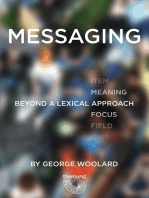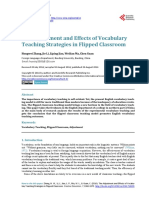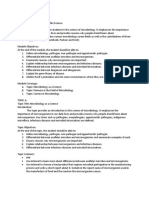The Audiolingual Method
The Audiolingual Method
Uploaded by
Imelda MallipaCopyright:
Available Formats
The Audiolingual Method
The Audiolingual Method
Uploaded by
Imelda MallipaOriginal Description:
Original Title
Copyright
Available Formats
Share this document
Did you find this document useful?
Is this content inappropriate?
Copyright:
Available Formats
The Audiolingual Method
The Audiolingual Method
Uploaded by
Imelda MallipaCopyright:
Available Formats
The Audiolingual Method Overview
The next revolution in terms of language teaching methodology coincided with World War II, when America became aware that it needed people to learn foreign languages very quickly as part of its overall military operations. The "Army Method" was suddenly developed to build communicative competence in translators through very intensive language courses focusing on aural/oral skills. This in combination with some new ideas about language learning coming from the disciplines of descriptive linguistics and behavioral psychology went on to become what is known as the Audiolingual Method (ALM). This new method incorporated many of the features typical of the earlier Direct Method, but the disciplines mentioned above added the concepts of teaching linguistic patterns in combination with something generally referred to as "habit-forming". This method was one of the first to have its roots "firmly grounded in linguistic and psychological theory" (Brown 1994:57), which apparently added to its credibility and probably had some influence in the popularity it enjoyed over a long period of time. It also had a major influence on the language teaching methods that were to follow, and can still be seen in major or minor manifestations of language teaching methodology even to this day. Another factor that accounted for the method's popularity was the quick success it achieved in leading learners towards communicative competence. Through extensive mimicry, memorization and overlearning of language patterns and forms, students and teachers were often able to see immediate results. This was both its strength and its failure in the long run, as critics began to point out that the method did not deliver in terms of producing long-term communicative ability. The study of linguistics itself was to change, and the area of second language learning became a discipline in its own right. Cognitive psychologists developed new views on learning in general, arguing that mimicry and rote learning could not account for the fact that language learning involved affective and interpersonal factors, that learners were able to produce language forms and patterns that they had never heard before. The idea that thinking processes themselves led to the discovery of independent language rule formation (rather than "habit formation"), and a belief that affective factors influenced their application, paved the way toward the new methods that were to follow the Audiolingual Method.
Objectives
Just as with the Direct Method that preceded it, the overall goal of the Audiolingual Method was to create communicative competence in learners. However, it was thought that the most effective way to do this was for students to "overlearn" the language being studied through extensive repetition and a variety of elaborate drills. The idea was to project the linguistic patterns of the language (based on the studies of structural linguists) into the minds of the learners in a way that made responses automatic and "habitual". To this end it was held that the language "habits" of the first language would constantly interfere, and the only way to overcome ths problem was to facilitate the learning of a new set of "habits" appropriate linguistically to the language being studied.
Key Features
Here is a summary of the key features of the Audiolingual Method, taken from Brown (1994:57) and adapted from Prator and Celce-Murcia (1979). (1) New material is presented in dialog form. (2) There is dependence on mimicry, memorization of set phrases, and overlearning.
http://www.englishraven.com/method_audioling.html
Accessed 10 January 2010
(3) Structures are sequenced by means of contrastive analysis and taught one at a time. (4) Structural patterns are taught using repetitive drills. (5) There is little or no grammatical explanation. Grammar is taught by inductive analogy rather than deductive explanation. (6) Vocabulary is strictly limited and learned in context. (7) There is much use of tapes, language labs, and visual aids. (8) Great importance is attached to pronunciation. (9) Very little use of the mother tongue by teachers is permitted. (10) Successful responses are immediately reinforced. (11) There is great effort to get students to produce error-free utterances. (12) There is a tendency to manipulate language and disregard content.
Typical Techniques
Larsen-Freeman, in her book Techniques and Principles in Language Teaching (1986:45-47) provides expanded descriptions of some common/typical techniques closely associated with the Audiolingual Method. The listing here is in summary form only. (1) Dialog Memorization (Students memorize an opening dialog using mimicry and applied role-playing) (2) Backward Build-up (Expansion Drill) (Teacher breaks a line into several parts, students repeat each part starting at the end of the sentence and "expanding" backwards through the sentence, adding each part in sequence) (3) Repitition Drill (Students repeat teacher's model as quickly and accurately as possible) (4) Chain Drill (Students ask and answer each other one-by-one in a circular chain around the classroom ) (5) Single Slot Substitution Drill (Teacher states a line from the dialog, then uses a word or a phrase as a "cue" that students, when repeating the line, must substitute into the sentence in the correct place) (6) Multiple-slot Substitution Drill (Same as the Single Slot drill, except that there are multiple cues to be substituted into the line) (7) Transformation Drill (Teacher provides a sentence that must be turned into something else, for example a question to be turned into a statement, an active sentence to be turned into a negative statement, etc)
http://www.englishraven.com/method_audioling.html
Accessed 10 January 2010
(8) Question-and-answer Drill (Students should answer or ask questions very quickly) (9) Use of Minimal Pairs (Using contrastive analysis, teacher selects a pair of words that sound identical except for a single sound that typically poses difficulty for the learners - students are to pronounce and differentiate the two words) (10) Complete the Dialog (Selected words are erased from a line in the dialog - students must find and insert) (11) Grammar Games (Various games designed to practice a grammar point in context, using lots of repetition)
http://www.englishraven.com/method_audioling.html
Accessed 10 January 2010
You might also like
- Ebook PDF Corporate Governance Principles Policies and Practices 3rd Canadian Edition PDFDocument41 pagesEbook PDF Corporate Governance Principles Policies and Practices 3rd Canadian Edition PDFwilliam.bodrick959100% (54)
- Fly Tying I Instructional BookletDocument32 pagesFly Tying I Instructional Bookletjanjicbojan100% (1)
- Messaging: beyond a lexical approach in ELTFrom EverandMessaging: beyond a lexical approach in ELTRating: 5 out of 5 stars5/5 (1)
- Traditional Language Teaching MethodsDocument18 pagesTraditional Language Teaching MethodsPauline Karen ConcepcionNo ratings yet
- Audiolingual MethodDocument14 pagesAudiolingual MethoddoniarisNo ratings yet
- TEFL English Language Teaching MethodologyDocument24 pagesTEFL English Language Teaching MethodologyYour Local MemeistNo ratings yet
- The Audio-Lingual MethodDocument40 pagesThe Audio-Lingual MethodHairin FadlihNo ratings yet
- Audiolongual Method 2Document3 pagesAudiolongual Method 2Nurfaiza BoneNo ratings yet
- Topic 1Document9 pagesTopic 1Ainhoa Sempere IlazarriNo ratings yet
- Approaches and Methods in Language Teaching-NotasDocument13 pagesApproaches and Methods in Language Teaching-NotasAnairamNo ratings yet
- Methods of ELT PDFDocument65 pagesMethods of ELT PDFNaman MeenaNo ratings yet
- The Audio-Lingual MethodDocument5 pagesThe Audio-Lingual MethodM JaanNo ratings yet
- Man Aol 1Document5 pagesMan Aol 1cabuliwallahNo ratings yet
- The Audio Lingual Method of Learning and TeachingDocument10 pagesThe Audio Lingual Method of Learning and TeachingMomina ButtNo ratings yet
- Resume Tefl 1Document7 pagesResume Tefl 1Arin Dwi OktarindaNo ratings yet
- Basic Classification of MethodsDocument5 pagesBasic Classification of MethodsсевинджNo ratings yet
- Communicative Approach vs. Audio-Lingual MethodDocument10 pagesCommunicative Approach vs. Audio-Lingual Methodkitkat1122334480% (5)
- Audiolingual Method AND Silent Way MethodDocument12 pagesAudiolingual Method AND Silent Way MethodRiani pohanNo ratings yet
- C) Research Study Q3. With Reference To The Following Framework, Enumerate With Examples The Application of MethodologiesDocument6 pagesC) Research Study Q3. With Reference To The Following Framework, Enumerate With Examples The Application of MethodologiesNidhi MathurNo ratings yet
- English Language Teaching MethodologyDocument41 pagesEnglish Language Teaching Methodologyemo_trans100% (1)
- 1401-Article Text-3637-1-10-20170517Document16 pages1401-Article Text-3637-1-10-20170517thwegraceNo ratings yet
- MethodsDocument9 pagesMethodsGoga RadNo ratings yet
- TOPIC 1 InglésDocument12 pagesTOPIC 1 Ingléselena.rihondoNo ratings yet
- Memory Vocabulary Learning Strategies and Long-TermDocument12 pagesMemory Vocabulary Learning Strategies and Long-TermEsmeralda Yépez ArellanoNo ratings yet
- Chapter 4Document18 pagesChapter 4Jackaii Waniwan IINo ratings yet
- Methods and Approaches in Vocabulary Teaching PDFDocument47 pagesMethods and Approaches in Vocabulary Teaching PDFRody BudeșNo ratings yet
- Audio Lingual MethodDocument12 pagesAudio Lingual MethodMilton Martinez88% (8)
- Methods For H.S 3Document9 pagesMethods For H.S 3Free Music collectionNo ratings yet
- The Audio-Lingual Methodطرائق انكليزيDocument17 pagesThe Audio-Lingual Methodطرائق انكليزيمعتصم عبدالسلام سلطانNo ratings yet
- Approaches and Methods in Language TeachingDocument10 pagesApproaches and Methods in Language TeachingAlma Jegić100% (2)
- The Adjustment and Effects of Vocabulary TeachingDocument8 pagesThe Adjustment and Effects of Vocabulary TeachingAnzhelika NestorNo ratings yet
- An Analysis of Language Teaching Approaches and MethodsDocument3 pagesAn Analysis of Language Teaching Approaches and MethodsNatalia IsabelNo ratings yet
- GTM VS Al VS DMDocument3 pagesGTM VS Al VS DMayaattalah4019No ratings yet
- Introducing Vocabulary Memorization Strategies To First Year Chinese University StudentsDocument9 pagesIntroducing Vocabulary Memorization Strategies To First Year Chinese University StudentsaisyahkarinaNo ratings yet
- ALM by Hajer and OualaDocument3 pagesALM by Hajer and OualaOuala MaafaNo ratings yet
- Audio-Lingual Method (Assignment)Document13 pagesAudio-Lingual Method (Assignment)Lisa Kwan100% (12)
- Audio LingualDocument6 pagesAudio LingualGlory MaeNo ratings yet
- Teaching Grammar, CLT Versus GTM: Numonova SaidaDocument12 pagesTeaching Grammar, CLT Versus GTM: Numonova Saidablue soldeNo ratings yet
- A. The Direct Method: Page of 1 3Document3 pagesA. The Direct Method: Page of 1 3Em DraperNo ratings yet
- Enlightened Eclectic ApproachDocument7 pagesEnlightened Eclectic Approachmusicdance880% (1)
- 13Document9 pages13Gemma Cañadas JimenezNo ratings yet
- TEFL2010 Lesson01 ELT Methodology Some Background IssuesDocument22 pagesTEFL2010 Lesson01 ELT Methodology Some Background IssuesdessyNo ratings yet
- Oscar Alfredo Torres Apa Audiolingual MethodDocument10 pagesOscar Alfredo Torres Apa Audiolingual Methodoscar-30No ratings yet
- Jurnal TerbaruDocument6 pagesJurnal Terbarurosalinda saragihNo ratings yet
- Chapter 2MDocument15 pagesChapter 2MMohamed JumaNo ratings yet
- Audio Lingual MethodDocument6 pagesAudio Lingual MethodJoyce Voon Ern CzeNo ratings yet
- Audio Lingual WordDocument7 pagesAudio Lingual WordASELA PE?FIELNo ratings yet
- Understanding T-WPS OfficeDocument9 pagesUnderstanding T-WPS OfficeEn RaniNo ratings yet
- The Direct MethodDocument6 pagesThe Direct MethodparsarouhNo ratings yet
- WEEK 3 Resources ForDocument10 pagesWEEK 3 Resources ForHanoveraNo ratings yet
- 2.ELT MethodologyDocument18 pages2.ELT MethodologyAbdou Kader0% (1)
- Analysis of Approachs and MethodsDocument3 pagesAnalysis of Approachs and Methodskwimo23No ratings yet
- An Overview of Second Language TeachingDocument22 pagesAn Overview of Second Language TeachingEvelyn Miluska Villena MorenoNo ratings yet
- The Direct Method BA 3rdDocument39 pagesThe Direct Method BA 3rdMan Bdr JoraNo ratings yet
- Direct MethodDocument10 pagesDirect MethodAmrit BanthaNo ratings yet
- The Audi - Lingual Method ZuhalDocument5 pagesThe Audi - Lingual Method ZuhalhighlwlwtNo ratings yet
- Tesol - Methods Comparison.Document2 pagesTesol - Methods Comparison.glenrd90No ratings yet
- English Language Teaching MethodologyDocument6 pagesEnglish Language Teaching MethodologywildfloNo ratings yet
- Methods of TeachingDocument28 pagesMethods of TeachingШоира ХоджаеваNo ratings yet
- Multilingualism and Translanguaging in Chinese Language ClassroomsFrom EverandMultilingualism and Translanguaging in Chinese Language ClassroomsNo ratings yet
- W M S U C L : Sample Complaint and AnswerDocument7 pagesW M S U C L : Sample Complaint and AnswerRomel Gregg TorresNo ratings yet
- ÔN TẬP TIẾNG ANHDocument11 pagesÔN TẬP TIẾNG ANHNguyễn Bảo Ngọc Giáo viên trường THCS thị trấn QuếNo ratings yet
- FADM Assignment Part2 (Section1 Group13) DM Number NameDocument8 pagesFADM Assignment Part2 (Section1 Group13) DM Number NameVimal AgrawalNo ratings yet
- Best 100 ScenesDocument98 pagesBest 100 Scenesmeno7No ratings yet
- Eddie Daniels Saxophone JournalDocument6 pagesEddie Daniels Saxophone JournalMattinNo ratings yet
- FAR Capital Service Agreement - FAR7 (RM 5,567) 29.10.19 PDFDocument7 pagesFAR Capital Service Agreement - FAR7 (RM 5,567) 29.10.19 PDFHazim Sufyan50% (2)
- Sdo Crew2 4-6 Sep 2023Document19 pagesSdo Crew2 4-6 Sep 2023nurul.sunusi17No ratings yet
- VP Sales Investment Solutions in Boston MA Resume Mark SwiderskiDocument2 pagesVP Sales Investment Solutions in Boston MA Resume Mark SwiderskiMarkSwiderskiNo ratings yet
- Acupoint Stimulation For AcneDocument22 pagesAcupoint Stimulation For AcneCristian SauraNo ratings yet
- 12300002Document11 pages12300002Kepweng ManggagamotNo ratings yet
- Wisest and Brighest of MankindDocument13 pagesWisest and Brighest of MankindFaisal JahangeerNo ratings yet
- J Zeisel ResumeDocument1 pageJ Zeisel ResumeJosh ZeiselNo ratings yet
- Philippine Culture and TraditionsDocument21 pagesPhilippine Culture and TraditionsFlorence Joy SorianoNo ratings yet
- Eagleeye Msrcamera QuicktipsDocument2 pagesEagleeye Msrcamera QuicktipsMiguel Ángel de PablosNo ratings yet
- Data Mining and Warehousing: Kapil SharmaDocument55 pagesData Mining and Warehousing: Kapil SharmaShreya SwapnilNo ratings yet
- The Notions of Literal and Non Literal M PDFDocument277 pagesThe Notions of Literal and Non Literal M PDFOliviaNo ratings yet
- Proud - Mary ReM V3 mscr4Document18 pagesProud - Mary ReM V3 mscr4aloisetdelphineNo ratings yet
- Community Engagement, Solidarity and CitizenshipDocument49 pagesCommunity Engagement, Solidarity and CitizenshipJona Mempin100% (1)
- Test Modal Verbs 2 Medio - SOLANGE SANCHEZDocument3 pagesTest Modal Verbs 2 Medio - SOLANGE SANCHEZVictor QuiñonesNo ratings yet
- Difference Between Windows 2000 and 2003 Server (For Interview)Document2 pagesDifference Between Windows 2000 and 2003 Server (For Interview)naiksandeepmNo ratings yet
- Contemporary SculptureDocument10 pagesContemporary SculptureJerwin Kennard BacaniNo ratings yet
- Module 1Document7 pagesModule 1mirai desuNo ratings yet
- Business Decision-MakingDocument3 pagesBusiness Decision-Makingevenkat35No ratings yet
- Mathematics 6 - First SemesterDocument57 pagesMathematics 6 - First Semester세드릭No ratings yet
- List Irregular VerbsDocument2 pagesList Irregular Verbsanasmateussa2078No ratings yet
- MATH11 - ABM - Applied Economics - Q2 - Module10 - Viability and Impacts of Business On The CommunityDocument16 pagesMATH11 - ABM - Applied Economics - Q2 - Module10 - Viability and Impacts of Business On The CommunityEllen DadivasNo ratings yet
- BANKING AND INSURANCE LAW Sullanus and PypDocument4 pagesBANKING AND INSURANCE LAW Sullanus and PypHarsha RaoNo ratings yet
- Ais 132 Draft d9 SSVDocument24 pagesAis 132 Draft d9 SSVototNo ratings yet

























































































